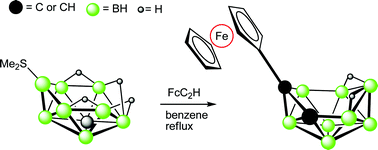Synthesis and electrochemistry of some ferrocenyl substituted dicarba- and tricarbaborane compounds†
Abstract
Treatment of arachno-4-Me2S-B9H13 (1) with ![[triple bond, length as m-dash]](https://www.rsc.org/images/entities/char_e002.gif) CH
CH

* Corresponding authors
a
Institute of Inorganic Chemistry, Academy of Sciences of the Czech Republic, 250 68 Řež, Czech Republic
E-mail:
stibr@iic.cas.cz
Fax: +420220940157
Tel: +420 266173106
b Department of Inorganic Chemistry, Faculty of Science, Charles University in Prague, Hlavova 2030, Prague 2, Czech Republic
Treatment of arachno-4-Me2S-B9H13 (1) with ![[triple bond, length as m-dash]](https://www.rsc.org/images/entities/char_e002.gif) CH
CH

 Please wait while we load your content...
Something went wrong. Try again?
Please wait while we load your content...
Something went wrong. Try again?
J. Holub, B. Štíbr, P. Štěpnička and I. Císařová, Dalton Trans., 2010, 39, 2057 DOI: 10.1039/B919767B
To request permission to reproduce material from this article, please go to the Copyright Clearance Center request page.
If you are an author contributing to an RSC publication, you do not need to request permission provided correct acknowledgement is given.
If you are the author of this article, you do not need to request permission to reproduce figures and diagrams provided correct acknowledgement is given. If you want to reproduce the whole article in a third-party publication (excluding your thesis/dissertation for which permission is not required) please go to the Copyright Clearance Center request page.
Read more about how to correctly acknowledge RSC content.
 Fetching data from CrossRef.
Fetching data from CrossRef.
This may take some time to load.
Loading related content
